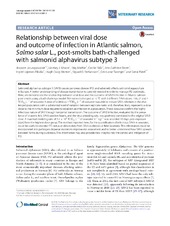| dc.contributor.author | Jarungsriapisit, Jiraporn | |
| dc.contributor.author | Moore, Lindsey | |
| dc.contributor.author | Mæhle, Stig | |
| dc.contributor.author | Skår, Cecilie Kristin | |
| dc.contributor.author | Einen, Ann Cathrine B. | |
| dc.contributor.author | Fiksdal, Ingrid Uglenes | |
| dc.contributor.author | Morton, Hugh Craig | |
| dc.contributor.author | Stefansson, Sigurd Olav | |
| dc.contributor.author | Taranger, Geir Lasse | |
| dc.contributor.author | Patel, Sonal | |
| dc.date.accessioned | 2016-11-30T12:35:46Z | |
| dc.date.available | 2016-11-30T12:35:46Z | |
| dc.date.issued | 2016-10-19 | |
| dc.Published | Veterinary Research 2016, 47(1):102 | eng |
| dc.identifier.issn | 0928-4249 | en_US |
| dc.identifier.uri | https://hdl.handle.net/1956/13164 | |
| dc.description.abstract | Salmonid alphavirus subtype 3 (SAV3) causes pancreas disease (PD) and adversely affects salmonid aquaculture in Europe. A better understanding of disease transmission is currently needed in order to manage PD outbreaks. Here, we demonstrate the relationship between viral dose and the outcome of SAV3 infection in Atlantic salmon post-smolts using a bath challenge model. Fish were challenged at 12 °C with 3 different SAV3 doses; 139, 27 and 7 TCID50 L−1 of seawater. A dose of as little as 7 TCID50 L−1 of seawater was able to induce SAV3 infection in the challenged population with a substantial level of variation between replicate tanks and, therefore, likely represents a dose close to the minimum dose required to establish an infection in a population. These data also confirm the highly infectious nature of SAV through horizontal transmission. The outcome of SAV3 infection, evaluated by the prevalence of viraemic fish, SAV3-positive hearts, and the virus shedding rate, was positively correlated to the original SAV3 dose. A maximal shedding rate of 2.4 × 104 TCID50 L−1 of seawater h−1 kg−1 was recorded 10 days post-exposure (dpe) from the highest dose group. The method reported here, for the quantification of infectious SAV3 in seawater, could be useful to monitor PD status or obtain data from SAV3 outbreaks at field locations. This information could be incorporated into pathogen dispersal models to improve risk assessment and to better understand how SAV3 spreads between farms during outbreaks. This information may also provide new insights into the control and mitigation of PD. | en_US |
| dc.language.iso | eng | eng |
| dc.publisher | BioMed Central | en_US |
| dc.rights | Attribution CC BY | eng |
| dc.rights.uri | http://creativecommons.org/licenses/by/4.0 | eng |
| dc.title | Relationship between viral dose and outcome of infection in Atlantic salmon, Salmo salar L., post-smolts bath-challenged with salmonid alphavirus subtype 3 | en_US |
| dc.type | Peer reviewed | |
| dc.type | Journal article | |
| dc.date.updated | 2016-10-19T06:03:04Z | |
| dc.description.version | publishedVersion | en_US |
| dc.rights.holder | Copyright 2016 The Author(s) | en_US |
| dc.identifier.doi | https://doi.org/10.1186/s13567-016-0385-2 | |
| dc.identifier.cristin | 1403004 | |

